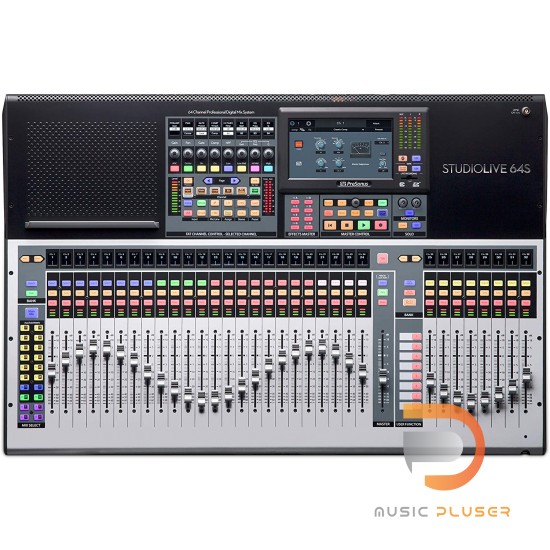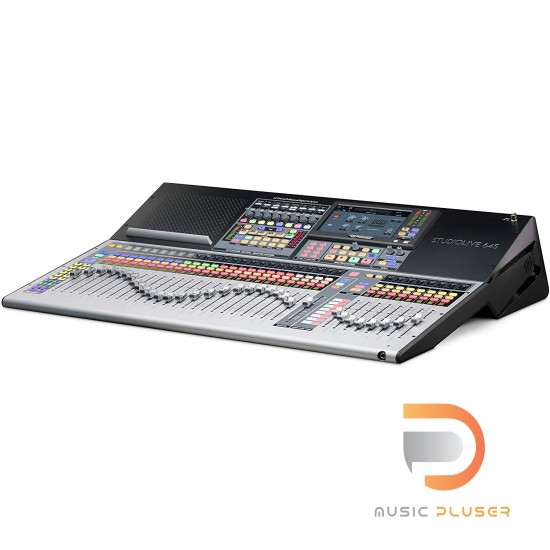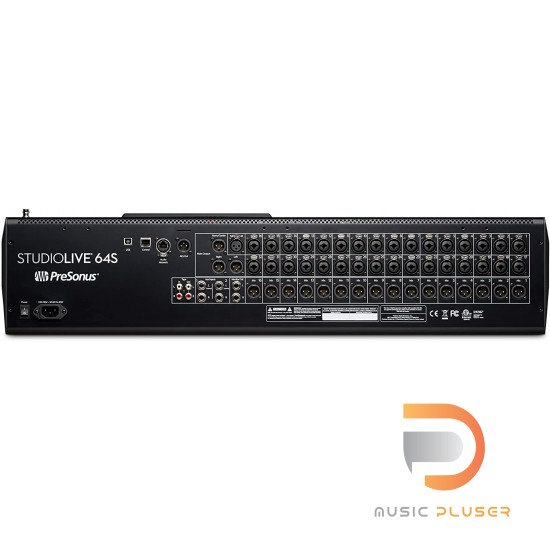





- Stock: In Stock
ตรวจสอบก่อน! ว่ามีสินค้าหรือไม่
*กรุณาโทรเช็คสต็อคสินค้าก่อนสั่ง 0811-444-729 - Model: PreSonus StudioLive 64S
The small format mixer with large format power.
The StudioLive 64S is a 64-channel mixer that brings the power of a large format console to small format digital mixing. Powered by the new quad-core PreSonus FLEX DSP Engine, the StudioLive 64S digital mixer is equipped with 76 mixing channels, 43 mix buses, and 526 simultaneous processors—including 8 stereo reverberation systems, and Fat Channel plug-in models on every input channel and mix bus. With 128 (64X64) channels of USB recording, 128 channels of AVB I/O, flexible routing options, and the studio-grade audio quality that made StudioLive mixers famous, the StudioLive 64S delivers a truly exceptional mixing experience that’s in a class of its own.
The best digital mixer for recording—with or without a computer.
PreSonus Capture® recording software is an intuitive multitrack recording application with a fully integrated Virtual Soundcheck mode that runs directly on your StudioLive 64S digital mixer or on your Mac® or Windows® computer. Record any combination of channels, FlexMixes, and the main stereo mix to USB, to an SD Card, or both for the ultimate redundant live recording rig. StudioLive mix scenes can be stored with your recordings to speed up Virtual Soundchecks. Best of all, Capture sessions open natively in Studio One® with the entire StudioLive mix scene re-created in the Studio One console, complete with fader levels, Fat Channel settings, mutes, solos, and more to launch your live mix right where you left it. No other multitrack software makes recording as fast, simple, and hassle-free so you can focus on mixing the show.
Superior sound.
We built our reputation designing great-sounding analog circuits for critical studio recording environments, and we put all of that experience into designing the StudioLive 64S digital mixer. In 1995, PreSonus patented digital control over analog circuits with our first studio product. Building on this legacy, we created a separate digital volume-control circuit ahead of our lauded analog XMAX mic preamp design, providing the convenience of digital recall without sacrificing fidelity. This allows the StudioLive 64S mic preamps to be remote-controlled with UC Surface software or Studio One, and when you load a StudioLive 64S mixer scene, the mic preamp trim values can be recalled along with the other settings.
Reconfigure your mix without unplugging a cable.
StudioLive Series III digital mixers incorporate the concept of an analog patchbay and digitize it. This lets you patch any analog input or digital return (AVB, USB, or SD Card) to any channel to customize your mix configuration. This flexible feature also allows you to freely route audio to your AVB network and record any of the inputs and FlexMixes on the 64 USB sends. Digital Patching also makes it easy to quickly route to and source from your AVB audio network when using the StudioLive 64S as part of a complete networked audio system.
The ultimate USB audio interface and control surface.
With 128 (64×64) channels of recording over USB, the StudioLive 64S is not just the best digital mixer for live sound recording; it’s the best digital mixer for the studio as well. Each channel can independently access its analog input or its dedicated digital return from your computer. While compatible with any DAW, Studio One and the StudioLive 64S are the perfect pair to elevate your studio recording environment. Remotely control your StudioLive 64S digital mixer’s recallable XMAX mic preamps and Fat Channel processing from Studio One Artist. Press the DAW button on your StudioLive 64S digital mixer and use the 33 touch-sensitive motorized faders to control your Studio One mix. Seamless integration and thoughtful bidirectional control with Studio One make the StudioLive 64S the best mixing console for the modern recording studio.
Get Connected.
The back panel of a StudioLive 64S digital mixer is equipped with plenty of local analog I/O. 32 local analog mic/line channel inputs make it easy to connect a variety of gear. 16 local mix outputs let you route to floor monitors, delay stacks and more. But the local I/O is only half the story. Connect your StudioLive 64S digital mixer to an AVB audio network and add remote inputs and outputs anywhere you need them using NSB-series stage boxes.
Features
- Powered by the new quad-core PreSonus FLEX DSP Engine to provide the most processing of any digital mixer in its class
- 76 input-channel digital mixer with 33 touch-sensitive motorized faders
- 64 channels (individually sourced from any of the 32 local digitally controlled XMAX mic/line inputs or any AVB, USB, or SD input)
- 2 balanced stereo aux inputs
- 1 stereo tape input (RCA, Bluetooth™ connectivity, USB, AVB or SD)
- 8 FLEX FX returns
- 1 Talkback
- 43 mix buses
- 32 FlexMixes (Aux, Subgroup, Matrix)
- 8 dedicated FLEX FX buses
- Stereo Main bus
- Main Mono/Center bus with per-channel level send and Center Divergence
- 526 simultaneous processors
- HPF
- Gate / Expander
- Compressor with Fat Channel plug-in models
- 4-band/6-band parametric EQ with Fat Channel plug-in models
- Limiter
- 31-band Graphic EQ
- 8 FLEX FX slots featuring legendary classic reverb emulations and delays
- State Space-Modeled Fat Channel compressor and EQ plug-ins available on every input channel and output bus
- FLEX FX multi-effects processor with 8 slots to load legendary reverb emulations and delays with 8 dedicated effects buses
- 24 DCAs to control groups of channels
- 128-channel (64×64) recording over USB
- Onboard multi-channel SD recorder (34×34) with true Virtual Soundcheck mode
- AVB Networking onboard (64×64) to connect with other mixers, NSB-series stage boxes, EarMix 16M personal monitor mixers and more
- User Profiles for managing multiple operators with custom permissions
- Per channel digital patching from any analog, AVB, USB, or SD Card source
- DAW Control
- Advanced Studio One control integration
- MCU emulation mode optimized for Logic
- HUI emulation mode optimized for Pro Tools
- Remote control every mix function from your computer, iPad, or Android tablet with UC Surface (included)
- Put your musicians’ monitor mix under their fingers with QMix-UC (included) for iOS or Android
- Capture multitrack software included
- Automated Virtual Soundcheck
- Store StudioLive mix scenes with your audio
- Advanced Studio One integration (Studio One Artist Included)
- XMAX mic preamp control from Studio One
- Control Fat Channel parameters from Studio One mixing console
Computer system requirements:
Below are the minimum computer-system requirements for UC Surface, QMix-UC, and Studio One®.
Mac
- macOS® 10.11 or higher (64-bit only)
- Intel® Core™ 2 Duo processor (Intel Core i3 or faster recommended)
- 4 GB RAM (8 GB or more recommended)
Windows
- Windows® 7 x64 SP1 + platform update, Windows 8.1 x64, Windows 10 x64
- Intel Core 2 Duo (Intel Core i3 or faster recommended)
- 4 GB RAM (8 GB or more recommended)
Mac and Windows Systems
- USB 2.0 port
- Internet connection
- Internal or external 7200 RPM storage drive highly recommended
- 30 GB hard disk space
- Monitor with 1366×768 resolution
iOS
- iOS 10 or later
- iPad Pro, iPad Air 2, iPad Air, iPad mini 4, iPad mini with Retina display, iPad (4th generation)
Android
- Android™ 5.0 (Lollipop) or later
- Android smartphone (QMix-UC)
- Android tablet (8-inch) with 1024×768 resolution (UC Surface)

